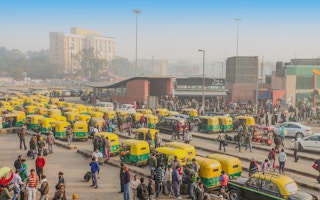Here’s a way to save $100 trillion and stop 1,700 million tonnes of carbon dioxide from getting into the atmosphere every year by 2050: cycle, walk or take public transport.
A new report by the University of California Davis and the Institute for Transportation and Development Policy (ITDP) estimates that such a policy would also prevent 1.4 million premature deaths a year from lung cancer and cardiopulmonary diseases.
The report, aimed to coincide with the current UN climate change summit in New York, sees sustainable public transport as a key factor in economic development.
Pollution controls
However, according to parallel analysis by the International Council on Clean Transportation, the planet’s governments must also demand the strongest vehicle pollution controls and push for ultra-low sulphur fuels.
The ITDP message is, of course, one that city planners, health chiefs, traffic analysts, atmospheric scientists and environmental campaigners have been urging for decades. The difference is that the new report, called A Global High Shift Scenario, attempts to estimate the money saved, the greenhouse gases not emitted, and the lives saved by a switch from the “business-as-usual” approach to transport.
“
Today, and out to 2050, lower income groups will have limited access to cars in most countries under almost any scenario, so improving access to modern, clean, high-capacity public transport is crucial
Lew Fulton, co-director of the NextSTEPS (Sustainable Transportation Energy Pathways) programme within the Institute of Transportation Studies at the University of California Davis
This would require governments everywhere to invest in clean, safe and swift public transport by bus and rail, and at the same time make the streets safe for cyclists and pedestrians.
If authorities also moved investment away from road construction, garages and parking lots, then enormous savings would follow over the next 35 years.
“Transportation, driven by rapid growth in car use, has been the fastest-growing source of CO2 in the world,” says Michael Replogle, ITDP’s founder and managing director for policy.
His co-author, Lew Fulton, co-director of the NextSTEPS (Sustainable Transportation Energy Pathways) programme within the Institute of Transportation Studies at the University of California Davis, adds: “The analysis shows that car-centric development will cut urban CO2 dramatically and also reduce costs, especially in rapidly expanding economies.”
Under the ITDP scenario, access to public transport would more than triple for the lowest income groups, and double for the next lowest income group. Overall, mobility tends to provide the poorest people with better access to employment and to services that will improve livelihoods.
Fulton says: “Today, and out to 2050, lower income groups will have limited access to cars in most countries under almost any scenario, so improving access to modern, clean, high-capacity public transport is crucial.”
Growing inequality
And Replogle warns: “Unmanaged growth in motor vehicle use threatens to exacerbate growing income inequality and environmental ills, while more sustainable transport delivers access for all, reducing these ills.”
Motor traffic in urban areas accounted for 2,300 megatonnes of carbon dioxide in 2010 –about a quarter of emissions from all parts of the transport sector. Rapid urbanisation in China, India and other fast-developing countries threatens to double these emissions.
Right now, the US is the world leader in carbon dioxide emissions from urban passenger transport, with 670 megatonnes a year. But the report calculates that this could be reduced to 280 megatonnes.
In China, the emissions from city transport are expected to rise from 190 megatonnes a year now to 1,100 megatonnes as the nation’s economy booms. Under the high shift scenario, this could be slashed to 650 megatonnes, with help from extensive investment in public transport.
Currently, Indian cities emit 70 megatonnes. This could rise to 540 megatonnes by 2050, but the report says that these could be contained at 350 megatonnes by addressing crucial deficiencies in India’s public transport.










